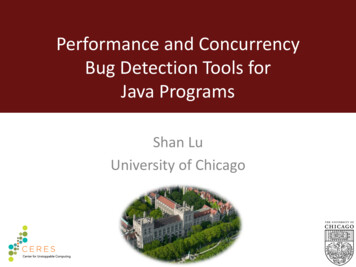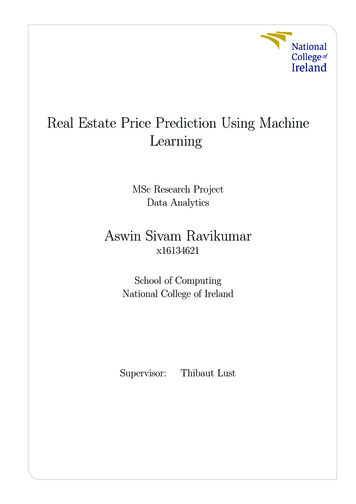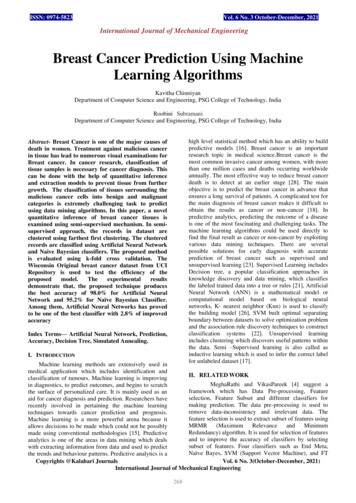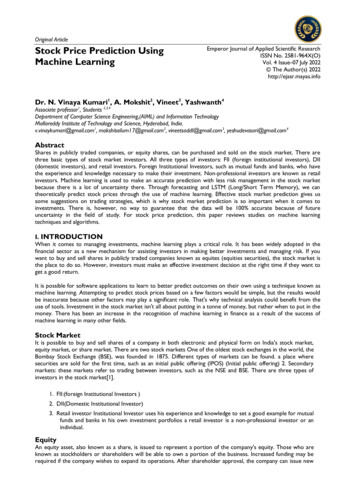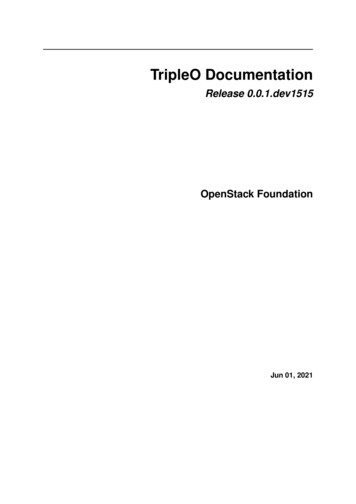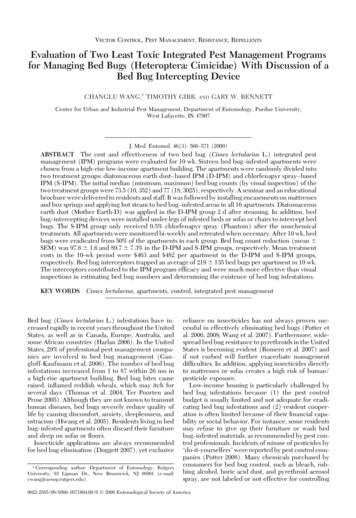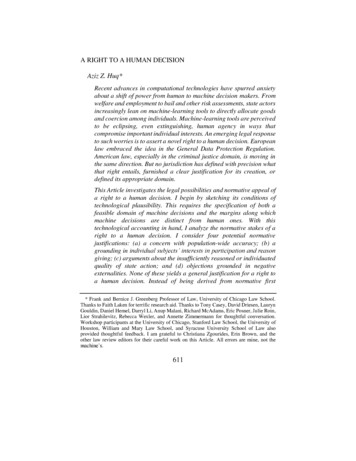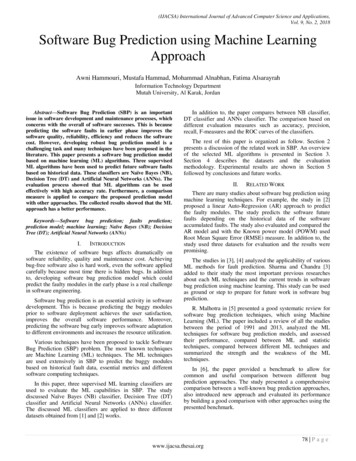
Transcription
(IJACSA) International Journal of Advanced Computer Science and Applications,Vol. 9, No. 2, 2018Software Bug Prediction using Machine LearningApproachAwni Hammouri, Mustafa Hammad, Mohammad Alnabhan, Fatima AlsarayrahInformation Technology DepartmentMutah University, Al Karak, JordanAbstract—Software Bug Prediction (SBP) is an importantissue in software development and maintenance processes, whichconcerns with the overall of software successes. This is becausepredicting the software faults in earlier phase improves thesoftware quality, reliability, efficiency and reduces the softwarecost. However, developing robust bug prediction model is achallenging task and many techniques have been proposed in theliterature. This paper presents a software bug prediction modelbased on machine learning (ML) algorithms. Three supervisedML algorithms have been used to predict future software faultsbased on historical data. These classifiers are Naïve Bayes (NB),Decision Tree (DT) and Artificial Neural Networks (ANNs). Theevaluation process showed that ML algorithms can be usedeffectively with high accuracy rate. Furthermore, a comparisonmeasure is applied to compare the proposed prediction modelwith other approaches. The collected results showed that the MLapproach has a better performance.Keywords—Software bug prediction; faults prediction;prediction model; machine learning; Naïve Bayes (NB); DecisionTree (DT); Artificial Neural Networks (ANNs)I.INTRODUCTIONThe existence of software bugs affects dramatically onsoftware reliability, quality and maintenance cost. Achievingbug-free software also is hard work, even the software appliedcarefully because most time there is hidden bugs. In additionto, developing software bug prediction model which couldpredict the faulty modules in the early phase is a real challengein software engineering.Software bug prediction is an essential activity in softwaredevelopment. This is because predicting the buggy modulesprior to software deployment achieves the user satisfaction,improves the overall software performance. Moreover,predicting the software bug early improves software adaptationto different environments and increases the resource utilization.Various techniques have been proposed to tackle SoftwareBug Prediction (SBP) problem. The most known techniquesare Machine Learning (ML) techniques. The ML techniquesare used extensively in SBP to predict the buggy modulesbased on historical fault data, essential metrics and differentsoftware computing techniques.In this paper, three supervised ML learning classifiers areused to evaluate the ML capabilities in SBP. The studydiscussed Naïve Bayes (NB) classifier, Decision Tree (DT)classifier and Artificial Neural Networks (ANNs) classifier.The discussed ML classifiers are applied to three differentdatasets obtained from [1] and [2] works.In addition to, the paper compares between NB classifier,DT classifier and ANNs classifier. The comparison based ondifferent evaluation measures such as accuracy, precision,recall, F-measures and the ROC curves of the classifiers.The rest of this paper is organized as follow. Section 2presents a discussion of the related work in SBP. An overviewof the selected ML algorithms is presented in Section 3.Section 4 describes the datasets and the evaluationmethodology. Experimental results are shown in Section 5followed by conclusions and future works.II.RELATED WORKThere are many studies about software bug prediction usingmachine learning techniques. For example, the study in [2]proposed a linear Auto-Regression (AR) approach to predictthe faulty modules. The study predicts the software futurefaults depending on the historical data of the softwareaccumulated faults. The study also evaluated and compared theAR model and with the Known power model (POWM) usedRoot Mean Square Error (RMSE) measure. In addition to, thestudy used three datasets for evaluation and the results werepromising.The studies in [3], [4] analyzed the applicability of variousML methods for fault prediction. Sharma and Chandra [3]added to their study the most important previous researchesabout each ML techniques and the current trends in softwarebug prediction using machine learning. This study can be usedas ground or step to prepare for future work in software bugprediction.R. Malhotra in [5] presented a good systematic review forsoftware bug prediction techniques, which using MachineLearning (ML). The paper included a review of all the studiesbetween the period of 1991 and 2013, analyzed the MLtechniques for software bug prediction models, and assessedtheir performance, compared between ML and statistictechniques, compared between different ML techniques andsummarized the strength and the weakness of the MLtechniques.In [6], the paper provided a benchmark to allow forcommon and useful comparison between different bugprediction approaches. The study presented a comprehensivecomparison between a well-known bug prediction approaches,also introduced new approach and evaluated its performanceby building a good comparison with other approaches using thepresented benchmark.78 P a g ewww.ijacsa.thesai.org
(IJACSA) International Journal of Advanced Computer Science and Applications,Vol. 9, No. 2, 2018D. L. Gupta and K. Saxena [7] developed a model forobject-oriented Software Bug Prediction System (SBPS). Thestudy combined similar types of defect datasets which areavailable at Promise Software Engineering Repository. Thestudy evaluated the proposed model by using the performancemeasure (accuracy). Finally, the study results showed that theaverage proposed model accuracy is 76.27%.Rosli et al. [8] presented an application using the geneticalgorithm for fault proneness prediction. The applicationobtains its values, such as the object-oriented metrics and countmetrics values from an open source software project. Thegenetic algorithm uses the application's values as inputs togenerate rules which employed to categorize the softwaremodules to defective and non-defective modules. Finally,visualize the outputs using genetic algorithm applet.The study in [9] assessed various object-oriented metrics byused machine learning techniques (decision tree and neuralnetworks) and statistical techniques (logical and linearregression). The results of the study showed that the CouplingBetween Object (CBO) metric is the best metric to predict thebugs in the class and the Line Of Code (LOC) is fairly well,but the Depth of Inheritance Tree (DIT) and Number OfChildren (NOC) are untrusted metrics.Singh and Chug [10] discussed five popular ML algorithmsused for software defect prediction i.e. Artificial NeuralNetworks (ANNs), Particle Swarm Optimization (PSO),Decision Tree (DT), Naïve Bayes (NB) and Linear Classifiers(LC). The study presented important results including that theANN has lowest error rate followed by DT, but the linearclassifier is better than other algorithms in term of defectprediction accuracy, the most popular methods used insoftware defect prediction are: DT, BL, ANN, SVM, RBL andEA, and the common metrics used in software defectprediction studies are: Line Of Code (LOC) metrics, objectoriented metrics such as cohesion, coupling and inheritance,also other metrics called hybrid metrics which used both objectoriented and procedural metrics, furthermore the resultsshowed that most software defect prediction studied usedNASA dataset and PROMISE dataset.Moreover, the studies in [11], [12] discussed various MLtechniques and provided the ML capabilities in software defectprediction. The studies assisted the developer to use usefulsoftware metrics and suitable data mining technique in order toenhance the software quality. The study in [12] determined themost effective metrics which are useful in defect predictionsuch as Response for class (ROC), Line of code (LOC) andLack Of Coding Quality (LOCQ).Bavisi et al. [13] presented the most popular data miningtechnique (k-Nearest Neighbors, Naïve Bayes, C-4.5 andDecision trees). The study analyzed and compared fouralgorithms and discussed the advantages and disadvantages ofeach algorithm. The results of the study showed that there weredifferent factors affecting the accuracy of each technique; suchas the nature of the problem, the used dataset and itsperformance matrix.The researches in [14], [15] presented the relationshipbetween object-oriented metrics and fault-proneness of a class.Singh et al. [14] showed that CBO, WMC, LOC, and RFC areeffective in predicting defects, while Malhotra and Singh [15]showed that the AUC is effective metric and can be used topredict the faulty modules in early phases of softwaredevelopment and to improve the accuracy of ML techniques.This paper discusses three well-known machine learningtechniques DT, NB and ANNs. The paper also evaluates theML classifiers using various performance measurements (i.e.accuracy, precision, recall, F-measure and ROC curve). Threepublic datasets are used to evaluate the three ML classifiers.On the other hand, most of the mentioned related worksdiscussed more ML techniques and different datasets. Some ofthe previous studies mainly focused on the metrics that makethe SBP as efficient as possible, while other previous studiesproposed different methods to predict software bugs instead ofML techniques.III.USED MACHINE LEARNING ALGORITHMSThe study aims to analyze and assess three supervisedMachine Learning algorithms, which are Naïve Bayes (NB),Artificial Neural Network (ANN) and Decision Tree (DT). Thestudy shows the performance accuracy and capability of theML algorithms in software bug prediction and provides acomparative analysis of the selected ML algorithms.The supervised machine learning algorithms try to developan inferring function by concluding relationships anddependencies between the known inputs and outputs of thelabeled training data, such that we can predict the output valuesfor new input data based on the derived inferring function.Following are summarized description of the selectedsupervised ML algorithms: Naïve Bayes (NB): NB is an efficient and simpleprobabilistic classifier based on Bayes theorem withindependence assumption between the features. NB isnot single algorithms, but a family of algorithms basedon common principle, which assumes that the presenceor absence of a particular feature of the class is notrelated to the presence and absence of any otherfeatures [16], [17]. Artificial Neural Networks (ANNs): ANNs are networksinspired by biological neural networks. Neural networksare non-linear classifier which can model complexrelationships between the inputs and the outputs. Aneural network consists of a collection of processingunits called neurons that are work together in parallel toproduce output [16]. Each connection between neuronscan transmit a signal to other neurons and each neuroncalculates its output using the nonlinear function of thesum of all neuron’s inputs. Decision Tree (DT): DT is a common learning methodused in data mining. DT refers to a hierarchal andpredictive model which uses the item’s observation asbranches to reach the item’s target value in the leaf. DTis a tree with decision nodes, which have more than onebranch and leaf nodes, which represent the decision.79 P a g ewww.ijacsa.thesai.org
(IJACSA) International Journal of Advanced Computer Science and Applications,Vol. 9, No. 2, 2018TABLE II.DS1 - THE FIRST SOFTWARE FAULTS DATASETDiTiDiFiDS2 - THE SECOND SOFTWARE FAULTS 53802716125532490021 ABLE ASETS AND EVALUATION METHODOLOGYThe used datasets in this study are three different datasets,namely DS1, DS2 and DS3. All datasets are consisting of twomeasures; the number of faults (Fi) and the number of testworkers (Ti) for each day (Di) in a part of software projectslifetime. The DS1 dataset has 46 measurements that involvedin the testing process presented in [1]. DS2, also taken from[1], which measured a system faults during 109 successivedays of testing the software system that consists of 200modules with each having one kilo line of code of Fortran.DS2 has 111 measurements. DS3 is developed in [2], whichcontains real measured data for a test/debug program of a realtime control application presented in [18]. Tables I to IIIpresent DS1, DS2 and DS3, respectively.The datasets were preprocessed by a proposed clusteringtechnique. The proposed clustering technique marks the datawith class labels. These labels are set to classify the number offaults into five different classes; A, B, C, D, and E. Table IVshows the value of each class and number of instances thatbelong to it in each dataset.In order to evaluate the performance of using MLalgorithms in software bug prediction, we used a set of wellknown measures [19] based on the generated confusionmatrixes. The following subsections describe the confusionmatrix and the used evaluation measures.A. Confusion MatrixThe confusion matrix is a specific table that is used tomeasure the performance of ML algorithms. Table V shows anexample of a generic confusion matrix. Each row of the matrixrepresents the instances in an actual class, while each columnrepresents the instance in a predicted class or vice versa.Confusion matrix summarizes the results of the testingalgorithm and provides a report of the number of True Positive(TP), False Positives (FP), True Negatives (TN), and FalseNegatives (FN).80 P a g ewww.ijacsa.thesai.org
(IJACSA) International Journal of Advanced Computer Science and Applications,Vol. 9, No. 2, 2018TABLE 139775766412678116DS3 - THE THIRD SOFTWARE FAULTS E 11102241041102001100001010000201020C. Precision (Positive Predictive Value)Precision is calculated as the number of correct positivepredictions divided by the total number of positive predictions.The best precision is 1, whereas the worst is 0 and it can becalculated as:Ti22222222221113121112112111121112222Precision TP / ( TP FP )D. Recall (True Positive Rate or Sensitivity)Recall is calculated as the number of positive predictionsdivided by the total number of positives. The best recall is 1,whereas the worst is 0. Generally, Recall is calculated by thefollowing formula:Recall TP / ( TP FN )Number of FaultsABCDE0-45-910-1415-19More than 20TABLE VI.F- measure (2* Recall * Precision)/(Recall Precision) ActualClass XTPFPClass YFNTNTABLE VII.B. AccuracyAccuracy (ACC) is the proportion of true results (both TPand TN) among the total number of examined instances. Thebest accuracy is 1, whereas the worst accuracy is 0. ACC canbe computed by using the following formula:ACC (TP TN) / (TP TN FP FN)EXPERIMENTAL RESULTSThe accuracy of NB, DT and ANNs classifiers for the threedatasets are shown in Table VI. As shown in Table VI, thethree ML algorithms achieved a high accuracy rate. Theaverage value for the accuracy rate in all datasets for the threeclassifiers is over 93% on average. However, the lowest valueappears for NB algorithm in the DS1 dataset. We believe this isbecause the dataset is small and NB algorithm needs a biggerdataset in order to achieve a higher accuracy value. Therefore,NB got a higher accuracy rate in DS2 and DS3 datasets, whichthey are relatively bigger than the DS1 dataset.THE CONFUSION MATRIXClass Y(5)This study used WEKA 3.6.9, a machine learning tool, toevaluate three ML algorithms (NB, DT and ANNs) in softwarebug prediction problem. A cross validation (10 fold) is used foreach dataset.Number of InstancesDS1DS2DS3307657523335418231450Class X(4)F. Root-Mean-Square Error (RMSE)RMSE is a measure for evaluating the performance of aprediction model. The idea herein is to measure the differencebetween the predicted and the actual values. If the actual valueis X and the predicted value is XP then RMSE is calculated asfollows:V.Predicted(3)E. F-measureF-measure is defined as the weighted harmonic mean ofprecision and recall. Usually, it is used to combine the Recalland Precision measures in one measure in order to comparedifferent ML algorithms with each other. F-measure formula isgiven by:NUMBER OF FAULTS CLASSIFICATIONFaults Class(2)(1)ACCURACY MEASURE FOR THE THREE ML ALGORITHMSOVER 81 P a g ewww.ijacsa.thesai.org
(IJACSA) International Journal of Advanced Computer Science and Applications,Vol. 9, No. 2, 2018TABLE VIII. PRECISION MEASURE FOR THE THREE ML ALGORITHMSOVER DATASETSDatasetsDS1DS2DS3AverageTABLE .9900.990DatasetsDS1DS2DS3RECALL MEASURE FOR THE THREE ML ALGORITHMS .959DT1111TABLE X.ANNs10.9900.9810.990The precision measures for applying NB, DT and ANNsclassifiers on DS1, DS2 and DS3 datasets are shown inTable VII. Results show that three ML algorithms can be usedfor bug prediction effectively with a good precision rate. Theaverage precision values for all classifiers in the three datasetsare more than 97%.The third evaluation measure is the recall measure.Table VIII shows the recall values for the three classifiers onthe three datasets. Also, herein the ML algorithms achieved agood recall value. The best recall value was achieved by DTclassifier, which is 100% in all datasets. On the other hand, theaverage recall values for ANNs and NB algorithms are 99%and 96%, respectively.In order to compare the three classifiers with respect torecall and precision measures, we used the F-measure value.Fig. 1 shows the F-measure values for the used ML algorithmsin the three datasets. As shown the figure, DT has the highestF-measure value in all datasets followed by ANNs, then NBclassifiers.Finally, to evaluate the ML algorithms with otherapproaches, we calculated the RMSE value. The work in [2]proposed a linear Auto Regression (AR) model to predict theaccumulative number of software faults using historicalmeasured faults. They evaluated their approach with thePOWM model [20] based on the RMSE measure. Theevaluation process was done on the same datasets we are usingin this study.VI.As a future work, we may involve other ML techniques andprovide an extensive comparison among them. Furthermore,adding more software metrics in the learning process is onepossible approach to increase the accuracy of the 2[5]0.91DS1DS2DS3[6]Fig. 1.F-measure values for the used ML algorithms in the threedatasets.CONCLUSIONS AND FUTURE WORKThe evaluation process is implemented using three realtesting/debugging datasets. Experimental results are collectedbased on accuracy, precision, recall, F-measure, and RMSEmeasures. Results reveal that the ML techniques are efficientapproaches to predict the future software bugs. The comparisonresults showed that the DT classifier has the best results overthe others. Moreover, experimental results showed that usingML approach provides a better performance for the predictionmodel than other approaches, such as linear AR and POWMmodel.[2]NBApproaches Presented in [2]AR ModelPOWM Model4.09614.0600.687150.0753.567152.969Software bug prediction is a technique in which aprediction model is created in order to predict the futuresoftware faults based on historical data. Various approacheshave been proposed using different datasets, different metricsand different performance measures. This paper evaluated theusing of machine learning algorithms in software bugprediction problem. Three machine learning techniques havebeen used, which are NB, DT and ANNs.0.980.96Machine Learning 1200.0620.162Table IX presents the RMSE measure for the used MLalgorithms, as well as, AR and POWM models over the threedatasets. The results show that NB, DT, and ANNs classifiershave better values than AR and POWM models. The averageRMSE value for all ML classifiers in the three datasets is0.130, while the average RMSE values for AR and POWMmodels are 2.783 and 105.701, respectively.10.99RMSE VALUES FOR THE THREE ML ALGORITHMS, ARMODEL, AND POWM MODELREFERENCESY. Tohman, K. Tokunaga, S. Nagase, and M. Y., “Structural approach tothe estimation of the number of residual software faults based on thehyper-geometric districution model,” IEEE Trans. on SoftwareEngineering, pp. 345–355, 1989.A. Sheta and D. Rine, “Modeling Incremental Faults of SoftwareTesting Process Using AR Models ”, the Proceeding of 4th InternationalMulti-Conferences on Computer Science and Information Technology(CSIT 2006), Amman, Jordan. Vol. 3. 2006.D. Sharma and P. Chandra, "Software Fault Prediction Using MachineLearning Techniques," Smart Computing and Informatics. Springer,Singapore, 2018. 541-549.R. Malhotra, "Comparative analysis of statistical and machine learningmethods for predicting faulty modules," Applied Soft Computing 21,(2014): 286-297Malhotra, Ruchika. "A systematic review of machine learningtechniques for software fault prediction." Applied Soft Computing 27(2015): 504-518.D'Ambros, Marco, Michele Lanza, and Romain Robbes. "An extensivecomparison of bug prediction approaches." Mining SoftwareRepositories (MSR), 2010 7th IEEE Working Conference on. IEEE,2010.82 P a g ewww.ijacsa.thesai.org
(IJACSA) International Journal of Advanced Computer Science and Applications,Vol. 9, No. 2, 2018[7][8][9][10][11][12][13]Gupta, Dharmendra Lal, and Kavita Saxena. "Software bug predictionusing object-oriented metrics." Sādhanā (2017): 1-15.M. M. Rosli, N. H. I. Teo, N. S. M. Yusop and N. S. Moham, "TheDesign of a Software Fault Prone Application Using EvolutionaryAlgorithm," IEEE Conference on Open Systems, 2011.T. Gyimothy, R. Ferenc and I. Siket, "Empirical Validation of ObjectOriented Metrics on Open Source Software for Fault Prediction," IEEETransactions On Software Engineering, 2005.Singh, Praman Deep, and Anuradha Chug. "Software defect predictionanalysis using machine learning algorithms." 7th InternationalConference on Cloud Computing, Data Science & EngineeringConfluence, IEEE, 2017.M. C. Prasad, L. Florence and A. Arya, "A Study on Software Metricsbased Software Defect Prediction using Data Mining and MachineLearning Techniques," International Journal of Database Theory andApplication, pp. 179-190, 2015.Okutan, Ahmet, and Olcay Taner Yıldız. "Software defect predictionusing Bayesian networks." Empirical Software Engineering 19.1 (2014):154-181.Bavisi, Shrey, Jash Mehta, and Lynette Lopes. "A Comparative Study ofDifferent Data Mining Algorithms." International Journal of CurrentEngineering and Technology 4.5 (2014).[14] Y. Singh, A. Kaur and R. Malhotra, "Empirical validation of objectoriented metrics for predicting fault proneness models," Software QualJ, p. 3–35, 2010.[15] Malhotra, Ruchika, and Yogesh Singh. "On the applicability of machinelearning techniques for object oriented software fault prediction."Software Engineering: An International Journal 1.1 (2011): 24-37.[16] A.TosunMisirli, A. se Ba S.Bener,“A Mapping Study on BayesianNetworks for Software Quality Prediction”, Proceedings of the 3rdInternational Workshop on Realizing Artificial Intelligence Synergies inSoftware Engineering, (2014).[17] T. Angel Thankachan1, K. Raimond2, “A Survey on Classification andRule Extraction Techniques for Data mining”,IOSR Journal ofComputer Engineering ,vol. 8, no. 5,(2013), pp. 75-78.[18] T. Minohara and Y. Tohma, “Parameter estimation of hyper-geometricdistribution software reliability growth model by genetic algorithms”, inProceedings of the 6th International Symposium on Software ReliabilityEngineering, pp. 324–329, 1995.[19] Olsen, David L. and Delen, “ Advanced Data Mining Techniques ”,Springer, 1st edition, page 138, ISBN 3-540-76016-1, Feb 2008.[20] L. H. Crow, “Reliability for complex repairable systems,” Reliabilityand Biometry, SIAM, pp. 379–410, 1974.83 P a g ewww.ijacsa.thesai.org
Abstract—Software Bug Prediction (SBP) is an important issue in software development and maintenance processes, which concerns with the overall of software successes. This is because predicting the software faults in earlier phase improves the software quality, reliability, efficiency and reduces the software cost.

